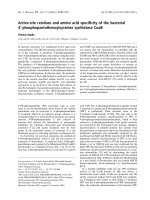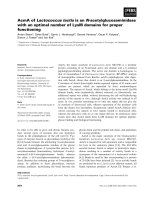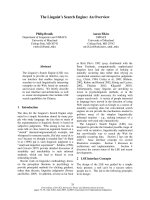Báo cáo khoa học: "Single site laparoscopic right hemicolectomy: an oncological feasible option" pot
Bạn đang xem bản rút gọn của tài liệu. Xem và tải ngay bản đầy đủ của tài liệu tại đây (654.1 KB, 3 trang )
REVIE W Open Access
Single site laparoscopic right hemicolectomy:
an oncological feasible option
Yon Kuei Lim, Kheng Hong Ng, Kong Weng Eu
*
Abstract
Introduction: We present the first 7 cases of single site right hemicolectomy in Asia using the new Single Site
Laparoscopy (SSL) access system from Ethicon Endo-surgery.
Methods: Right hemicolectomy was performed using the new Single Site Laparoscopy (SSL) access system. Patient
demographics, operative time, histology and post operative recovery and complications were collected and
analysed.
Results: The median operative time was 90 mins (range 60 - 150 mins) and a median wound size of 2.5 cm (range
2 to 4.5 cm). The median number of lymph nodes harvested was 24 (range 20 to 34 lymph nodes). The median
length of proximal margin was 70 mm (range 30 to 145 mm) and that of distal margin was 50 mm (35 to
120 mm). All patients had a median hospital stay of 7 days (range 5 to 11) and there were no significant
perioperative complications except for 1 patient who had a minor myocardial event.
Conclusion: Right hemicolectomy using SSL access system is feasible and safe for oncologic surgery.
Introduction
Since the advent of laparoscopy, ther e have been
advances and interest in m inimizing the size and num-
ber of access sites[1]. With the development of technical
skills, more surgeons are trained and are comfortable
doing laparoscopic colectomies, the next progression
would be to make surgery less invasive without compro-
mising safety. Minimally invasive colectomies have
evolved with hand-assisted laparoscopic, conventional
laparoscopic and possibly Natural Orifice Transluminal
Endoscopic Surgery (NOTES) in the future. Single site
laparoscopic surgery lies between conventional laparo-
scopic and NOTES, and aims to combine the advantages
of both approaches [2]. Here, we used the umbilicus, an
embr yologically natural orifice as the sole access in per-
forming right hemi colecto my for our series of patients,
which is the first in Asia using the latest SSL access
system.
Methods
From April till June 2010, we performed right hemico-
lectomy on 7 patients usi ng the new SSL access system.
In our centre, we performed approximately 220 laparo-
scopic colectomies per annum. The inclusion criteria
were that of a preoperative diagnosis of colonic neo-
plasm, as well as feasibility for single site approach
assessed after a diagnostic laparoscopy at the start of
surgery. The SSL access system (ETHICON E NDO-
SURGERY Inc, Cincinnati, OH, USA) consist of 2 main
components: a seal cap with accessories, and a fixed
length retractor. The seal cap consist of (2) 5 mm seals
and(1)5to15mmsealwithintheinnersealhousing
(figure 1). A reducer cap is preattached to the 15 mm
seal to accommodate use with a 5 mm instrument.
A stopcock valve is compatible with the standard luer
lock fittings and provides attachment for gas insuffla-
tions and desufflation. The fixed length retractor
consist s of 2 flexible rings interconnected by means of a
silicon sleeve (figure 2). Here we used the 2 cm dia-
meter retractor, which allows for an abdominal wall
thickness of up to 4 cm. No financial conflict nor
support was received from the device manufacturer.
We approached with an umbilical incision and a Has-
san port was inserted with a camera to evaluate feasibil-
ity of a laparoscopic resection. If deemed suitable, the
umbilic al incision was extended till between 1.5 to 2 cm
in size and the SSL access system used. The operating
* Correspondence:
Department of Colorectal Surgery, Singapore General Hospital, Outram Road,
Singapore
Lim et al. World Journal of Surgical Oncology 2010, 8:79
/>WORLD JOURNAL OF
SURGICAL ONCOLOGY
© 2010 Lim et al; licensee BioMed Central Ltd. This is an Open Access article distribut ed under the terms of the Creative Commons
Attribution License ( s/by/2.0), which permits unrestricte d use, distributio n, and reproduction in
any medium, provided the original work is properly cited.
table was rotated to obtain a left side down position to
allow gravity to retract the small bowel away. Mobilisa-
tion of the right colon was performed using the harmo-
nic scalpel and straight laparoscopic graspers (figure 3).
We performed a medial to lateral approach. The ileoco-
lic and right colic vessels were divided intracorporeally
where possible using a laparoscopic vascular stapler,
after the duodenum is identified and protected. In the
medial approach, the dissection is carried out tow ard
the hep atic flexure, followed by the lateral mobilisation.
Finally the transverse colon is mobilized and the hepatic
flexure taken down. The entire specimen was then
exteriorized and an e xtracorporeal anastomosis
performed.
Results
There were 4 males and 3 females with a median age of
62(range 63 -79) years who underwent right hemicolect-
omy with the SSL access system. They had an ASA
score of 2 or less. The median Body Mass Index (BMI)
was 22 (range 20.1 -30). The indication for surgery for
one patient was for a large flat tubular adenoma mea-
suring 2 by 5 cm in size at the hepatic flexure. The rest
had adenocarcinoma of the right colon, with a median
tumour length of 3.5 cm and width of 2.5 cm. The med-
ian operative time was 90 mins (range 60 - 150 mins),
slight blood loss(less than 20 mls) and a median wound
size of 2 cm (range 2 to 2.5 cm) (figure 4). Histology
rev ealed adenocarcinoma in 6 of the 7 spec imens and 1
was that of tubular adenoma with low grade dysplasia.
The median number of lymph nodes harvested was 24
(range 20 to 34 lymph nodes). The median length of
proxi mal margin was 70 mm (range 30 t o 145 mm) and
that of distal margin was 50 mm (35 to 120 mm).
Postoperatively, the patients had a median pain score
of 2(out of 10) on the day of the operation, and a score
of 2 on the 1
st
postoperative day. All had no significant
pain after the 2
nd
post-operative day. All patients had a
median hospital stay of 7 days (range 5 to 11 days) and
there were no significant perioperative complicatio ns,
other than 1 patient who had a minor myocardial
infarct. Specifically, none of the patients had surgical
site infection. All patient s stayed beyond commence-
ment of bowel function for social reasons.
Figure 1 Seal Cap.
Figure 2 Fixed Length retractor.
Figure 3 External view of instruments.
Lim et al. World Journal of Surgical Oncology 2010, 8:79
/>Page 2 of 3
Discussion
Single port access right hemicolectomy has been shown
to be feasible for oncologic surgery [ 3]. It may have
advant age over con ventional l aparosco pic surgery i n
terms of reduced pain, lower cost, faster recovery and
cosmesis [4]. There have been many different types of
single port access systems, each trying to improve on
previous models. Here, we evaluate the latest refine-
ment, which is the SSL access system.
There are several advantages using the new SSL access
system. The low profile seal cap enables us to use a
wide range of instruments. The integrated system also
eliminates the needs for trocars which might interfere
with the manipulation of instruments in the abdominal
cavity. Furthermore, 360 degrees seal cap rotation allows
quick reorientation of instruments throughout the sur-
gery without requiring instrument exchanges. At the
end of the procedure, the retractor of the SSL access
system also serves as a wound protector during speci-
men retrieval.
Here, we also demonstrate that single port right hemi-
colectomy is feasible with a reasonable operative time
(median 90 mins), and no significant perioperative com-
plications. Based on the histopathological report, there
were adequate lymph nodes (median 24 lymph nodes)
and resection margins (median proximal 70 mm, distal
50 mm) from the resected specimens. Our results are
comparable to other case reports and case series in the
literature [5-7], which have reported operative time
ranging from 115 to 255 mins.
In terms of patient preference, single port appendi-
cectomy has been shown to be the most favoured
method over open, conventional laparoscopic and
NOTES, extrapolating, perhaps this may be the
approach to invest in [8] for laparoscopic colectomies in
the future.
Conclusion
Right hemicolectomy using SSL acce ss system is feasible
and safe for oncologic surgery. It has encouraging
results in terms of oper ating time and postoperative
pain score. The favourable results thus far suggest this
may be the direction for the future of minimally invasive
colorectal surgery.
Authors’ contributions
LYK wrote the draft, did the data collection and analysed the results,
performed the statistical analysis, and finally wrote the final manuscript. NKH
conceived the idea and intellectual content as well as contributed in surgery
and contributed ideas to the manuscript. He participated in the design of
the study and coordination and helped to draft the manuscript. EKW
interpreted the data, assisted in coordination and revised the final
manuscript for intellectual content. All authors read and approved the final
manuscript.
Competing interests
The authors declare that they have no competing interests.
Received: 12 August 2010 Accepted: 8 September 2010
Published: 8 September 2010
References
1. Wong MT, Ng KH, Ho KS, Eu KW: Single-incision laparoscopic surgery for
right hemicolectomy: our initial experience with 10 cases. Tech
Coloproctol 2010, 14(3):225-228.
2. Bucher P, Pugin F, Morel P: Single port access laparoscopic right
hemicolectomy. Int J Colorectal Dis 2008, 23(10):1013-1016.
3. Choi SI, Lee KY, Park SJ, Lee SH: Single port laparoscopic right
hemicolectomy with D3 dissection for advanced colon cancer. World J
Gastroenterol 2010, 16(2):275-278.
4. Chambers W, Bicsak M, Lamparelli M, Dixon A: Single-incision laparoscopic
surgery (SILS) in complex colorectal surgery: a technique offering
potential and not just cosmesis. Colorectal Dis 2009.
5. Ramos-Valadez DI, Patel CB, Ragupathi M, Bartley Pickron T, Haas EM:
Single-incision laparoscopic right hemicolectomy: safety and feasibility
in a series of consecutive cases. Surg Endosc 2010.
6. Remzi FH, Kirat HT, Kaouk JH, Geisler DP: Single-port laparoscopy in
colorectal surgery. Colorectal Dis 2008, 10(8):823-826.
7. Uematsu D, Akiyama G, Magishi A, Nakamura J, Hotta K: Single-access
laparoscopic left and right hemicolectomy combined with
extracorporeal magnetic retraction. Dis Colon Rectum 2010, 53(6):944-948.
8. Rao A, Kynaston J, Macdonald ER, Ahmed I: Patient preferences for
surgical techniques: should we invest in new approaches? Surg Endosc
2010.
doi:10.1186/1477-7819-8-79
Cite this article as: Lim et al.: Single site laparoscopic right
hemicolectomy: an oncological feasible option. World Journal of Surgical
Oncology 2010 8:79.
Figure 4 Post-operative wound.
Lim et al. World Journal of Surgical Oncology 2010, 8:79
/>Page 3 of 3









